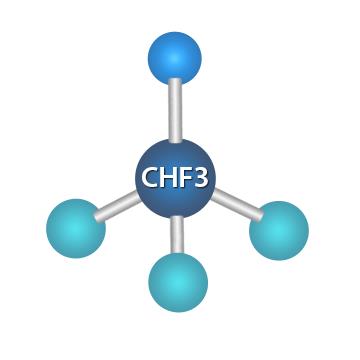| Identification | More | [Name]
Trifluoromethane | [CAS]
75-46-7 | [Synonyms]
CARBON TRIFLUORIDE
FC-13
FLUOROFORM
FREON 23
HALOCARBON 23
HFC-23
R-23
TRIFLUOROMETHANE
Arcton 1
arcton1
CHF3
EcoloAce23
fc23(fluorocarbon)
FE13
Fluoryl
Freon F-23
freonf-23
freonr23
Fron23
Genetron 23 | [EINECS(EC#)]
200-872-4 | [Molecular Formula]
CHF3 | [MDL Number]
MFCD00000446 | [Molecular Weight]
70.01 | [MOL File]
75-46-7.mol |
| Safety Data | Back Directory | [Hazard Codes ]
F | [Safety Statements ]
S38:In case of insufficient ventilation, wear suitable respiratory equipment . | [RIDADR ]
UN 1984 2.2
| [WGK Germany ]
1
| [RTECS ]
PB6900000
| [TSCA ]
T | [DOT Classification]
2.2 (Non-flammable gas) | [HazardClass ]
2.2 | [HS Code ]
2903410000 | [Safety Profile]
Narcotic in high
concentration. A mild respiratory irritant.
Mutation data reported. See also
FLUORIDES. When heated to
decomposition it emits toxic fumes of F-. | [Hazardous Substances Data]
75-46-7(Hazardous Substances Data) |
| Raw materials And Preparation Products | Back Directory | [Raw materials]
(1Z)-1,2-Dichloro-3,3,3-trifluoroprop-1-ene-->(1E)-1,2-Dichloro-3,3,3-trifluoroprop-1-ene-->2-Chloro-1,1,1,2-tetrafluoropropane-->Silane, trifluoro(trifluoromethyl)--->Methane, azidotrifluoro--->Silicon Tetrafluoride-->1,1,1,2,2-PENTAFLUOROPROPANE | [Preparation Products]
Lactofen-->TRIFLUOROACETALDEHYDE HYDRATE-->Sodium formate-->(TrifluoroMethyl)tris(triphenylphosphine)copper(I)-->[(difluoromethyl)thio]benzene-->3'-METHOXY-2,2,2-TRIFLUOROACETOPHENONE-->2-CHLORO-3,3,3-TRIFLUOROPROPENE |
| Hazard Information | Back Directory | [General Description]
Trifluoromethane is a colorless nonflammable gas. REFRIGERANT GAS R-23(75-46-7) is shipped as a liquid under pressure. REFRIGERANT GAS R-23(75-46-7) may be narcotic in high concentrations. Under prolonged exposure to fire or heat the containers may rupture violently and rocket. REFRIGERANT GAS R-23(75-46-7) is used as a refrigerant. | [Reactivity Profile]
TRIFLUOROMETHANE, R-23, is chemically inert in many situations, but can react violently with strong reducing agents such as the very active metals and the active metals. They suffer oxidation with strong oxidizing agents and under extremes of temperature. | [Health Hazard]
Vapors may cause dizziness or asphyxiation without warning. Vapors from liquefied gas are initially heavier than air and spread along ground. Contact with gas or liquefied gas may cause burns, severe injury and/or frostbite. Fire may produce irritating, corrosive and/or toxic gases. | [Fire Hazard]
Some may burn but none ignite readily. Containers may explode when heated. Ruptured cylinders may rocket. | [Description]
Trifluoromethane, CHF3, also known as fluoroform, propellant 23, and refrigerant 23, is a colorless gas that is nonflammable. There are no hazards listed for trifluoromethane. It may be an asphyxiant gas and displace oxygen in the air and in confined spaces. The four�digit UN identification number is 2035 for the compressed gas and 3136 for the cryogenic liquid. The primary uses for trifluoromethane are as a refrigerant, as a direct coolant for infrared detector cells, and as a blowing agent for urethane foams.

Strictly speaking, fluorocarbon compounds contain only the elements carbon, fluorine, and sometimes hydrogen. However, in industrial applications such as refrigerants and aerosol propellants, the term fluorocarbon has been used to include compounds containing chlorine and bromine atoms, or both. These industrial products have somewhat similar chemical and physical properties. Their relatively inert character and wide range of vapor pressures and boiling points make them especially well suited as refrigerants in a variety of applications, blowing agents for plastic foams, and aerosols. | [Chemical Properties]
Trifluoromethane, also known as Halocarbon-23, is a colorless, nonflammable, and nontoxic gas with a slight ethereal odor at ambient conditions. | [Uses]
Refrigerant for low temperetures. | [Uses]
The fluorocarbons covered in this monograph
are widely used as refrigerants, polymer intermediates,
and blowing agents in the manufacture
of polymerized foams used in insulation
and comfort cushioning. They are also used for
making packaging foams, as well as aerosol
propellants for products applied in foam or
spray form, and fire extinguishing agents. Special
mixtures of two or more fluorocarbons, or
fluorocarbons and hydrocarbons, are often used
to provide desired special properties in particular
refrigeration or aerosol propellant applications.
While Tetrafluoromethane is also used as a
low-temperature refrigerant gas, it is also widely
used by the electronics industry as a dry etchant
in microchip manufacture. It is blended with
oxygen and used to desmear and etch-back
"through holes" on printed circuit boards. | [Definition]
ChEBI: Fluoroform is a member of fluoromethanes. It has a role as a refrigerant. | [Hazard]
The four-digit UN identification number is 2035 for the compressed gas and 3136 for the cryogenic liquid. The primary uses for trifluoromethane are as a refrigerant, as a direct coolant for infrared detector cells, and as a blowing agent for urethane foams. | [Materials Uses]
The fluorocarbons are generally compatible
with most of the common metals except at high
temperatures. At elevated temperatures, the
following metals resist fluorocarbon corrosion
(and are named in decreasing order of their corrosive
resistance): Inconel, stainless steel,
nickel, steel, and bronze. Water or water vapor
in fluorocarbon systems will corrode magnesium
alloys or aluminum containing over 2 percent
magnesium. These metals are not recommended
for use with fluorocarbon systems in
which water may be present. | [Physiological effects]
The fluorocarbons used in industry generally
have low levels of toxicity, and hazards related
to their use are minimal. These compounds have
been extensively studied by many investigators
under a variety of conditions. | [storage]
Use forced ventilation and local exhaust, or
both, to prevent an accumulation of gas that
could reduce the oxygen level to below 19.5%.
Ensure good floor ventilation. Use a check
valve or trap in the discharge line to prevent
back flow into the cylinder. Where applicable,
use a pressure-reducing regulator when connecting
a cylinder to a low-pressure piping system.
For flammable fluorocarbons, adherence to
pertinent electrical standards is necessary. Personnel
should not weld, solder, braze, or have
an open flame of any type in atmospheres containing
flammable or nonflammable fluorocarbons. | [GRADES AVAILABLE]
Fluorocarbons are available for commercial and
industrial use in various grades with essentially
the same composition from one producer to
another. Purities of most fluorocarbon products
are a minimum of 99 volume percent. For special
applications very high purity grades are
available. |
|